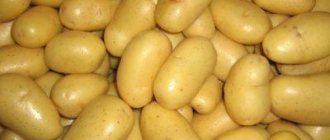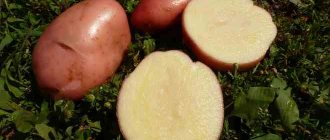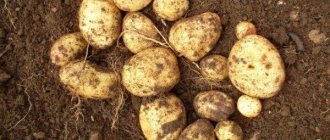Many vegetable growers like to experiment by growing unusual crops. Potatoes also have varieties that are distinguished by the exotic appearance of their tubers.
Gypsy potatoes are one of these interesting varieties. It is distinguished by tubers with dark purple skin. Gypsy captivates not only with its unusual appearance, but also with its delicate taste and rich aroma. For this, gardeners even forgive her for her demanding care and low transportability. Read on to learn about other advantages and disadvantages of this variety, as well as the nuances of agricultural technology.
What kind of potato is this?
Gypsy is an old variety of folk selection. It is unknown who exactly brought it out and in what year. This variety has gained popularity in the vast post-Soviet space.
Breeders believe that Gypsy is the product of crossing the Black Prince and the Blue Danube. But many agronomists disagree with this statement.
Some people think that Gypsy and Negritenok are the same variety. This opinion is erroneous, since the latter combines all the potatoes with purple pulp, while the Gypsy has anthocyanin only in the shell, and the inside of the tubers is white.
Distinctive features
The main difference between Gypsy and many other varieties is the unusual appearance of the tubers (with purple skin and white flesh). They are medium in size and oval in shape.
These potatoes are valued for their delicate taste with a rich aroma. The tubers contain an increased content of substances such as iodine, anthocyanin, potassium, magnesium, iron, as well as vitamins B, C, K and PP. Thanks to this, they help cleanse the body of harmful substances and have a positive effect on the condition of the thyroid gland and the body as a whole. The starch content in Tsyganka, on the contrary, is low - about 12%. The variety is recommended for children's and dietary nutrition.
Gypsy also has negative characteristics. This variety is characterized by increased demands on soil composition and watering; it also does not have high resistance to cold weather. The skin of the tubers is very thin, so they are not suitable for long-term transportation.
General characteristics of Gypsy
The Gypsy variety is not considered an unpretentious and hardy potato. Despite this, many vegetable growers continue to grow it because of its excellent taste and rich composition.
Description of the variety:
| Parameter | Index |
| Ground part of the plant | Low, medium-spreading, compact bushes reach a height of 50-70 cm. The leaves are small, dark green, with wavy edges and clearly defined purple veins. The stems are thick, with a purple (anthocyanin) tint. Large, bright blue flowers are collected in small corollas. Berries are rarely produced. The root system is powerful. |
| Tubers | Medium size. The weight of one varies between 100-120 g. The shape is irregular, oval. The potatoes are not wide and uneven, all of different shapes. The peel is thin, bright purple, glossy. There are few ocelli and they are not pigmented; they are distinguished by their superficial occurrence. The pulp is tender, sweetish, with a pronounced potato aroma. It has a cream color, with purple spots on the surface. When cooked it becomes crumbly. Starch content varies between 12-14%. |
| Ripening time | Mid-season. From planting to harvest it takes 70-90 days. |
| Productivity | High. Up to 250 centners are collected from 1 hectare. One bush produces up to 15 tubers. Some of them turn out to be non-marketable - too small. |
| Transportability | Not tall. The thin skin does not allow potatoes to be transported over long distances. The tubers are stored in a cool place all winter. |
| Immunity to disease | Is immune to most nightshade diseases. There is a possibility of late blight infection. |
| Features of cultivation | Recommended for cultivation in the central and southern regions of the country, including Kursk, Moscow, Belgorod, Rostov, and Ryazan regions. |
Description
Purple potatoes (see photo) are one of the potato varieties.
It has many names, for example, it can be called “blue French truffle potato”, “vitalot”, “Chinese truffle”, “negress”. It is believed that it first appeared in South America, because it is there that it is grown in large quantities even in our time. The tubers of this potato are dark purple in color, their shape is oblong, and the flesh inside is also purple. An interesting feature of the vegetable is that the rich purple color does not disappear even after heat treatment. The average length of one potato can reach ten centimeters, and weight - seventy grams. No wonder this exotic vegetable is considered a delicacy.
Agricultural technology
Planting potatoes is possible when the soil warms up to a temperature of 10˚C at a depth of 15 cm. In the southern regions this happens in early April, and in temperate climates - at the end. This option is not suitable for areas with short summers.
Preparation of planting material
Usually, by spring, potatoes germinate in the cellar on their own. If this does not happen, the process is stimulated artificially:
- The tubers are sorted. Choose a medium size, without stains, damage or traces of infection.
- Potatoes are placed in a place with a temperature of +17°C . They are laid in one row on sawdust or newspaper, and covered with a layer of newspaper or sawdust on top.
- I spray it with warm water every day from a spray bottle . After about two weeks, sprouts should appear.
Sprouted tubers are prepared for planting. This process consists of the following steps:
- The tubers are dipped in a solution prepared from 1 tsp. copper sulfate and 3 liters of water. After this, they are left in a warm place until completely dry.
- The planting material is rinsed with a product prepared from 0.5 tsp. boric acid and 3 liters of water. It is then allowed to dry completely.
- Potatoes are immersed in a solution of 1 tsp. “Mortar” and 3 liters of water. Then lay out in one row until completely dry.
- Two days before planting, the potatoes are taken to a place with a temperature of +10...+12°C.
Planting material treated in this way becomes more resilient and germinates faster. Disinfecting potatoes is the best prevention of diseases.
Important! Small specimens of Gypsy are not suitable for planting. Such planting material causes low yields and degeneration of the variety.
Preparing beds and planting
Potato beds are prepared in advance. A well-lit area of the garden is chosen for them. It is important that groundwater is not close to the surface.
Potatoes are not grown in one place for more than two years. This plant should not be planted after other nightshade crops.
Important! Potatoes are carriers of late blight. This fungus overwinters in its tubers. It is also this plant that attracts the Colorado potato beetle. It is not recommended to plant tomatoes, peppers, or eggplants next to it.
In the fall, the beds are dug up, clearing of plant debris. If the collected grass does not show signs of any diseases, it is useful to bury it to enrich the soil.
Humus or manure is additionally added to the soil at the rate of 6 kg per 1 sq. m. Then the acidity of the soil is measured with litmus paper. If the indicators are increased, for every 1 sq. m bring in a glass of ash.
In the spring, the beds are dug up and cleared of weeds. For each square meter, add 25 g of superphosphate and 15 g of urea. The beds are leveled with a rake and watered with hot copper sulfate: 1 tbsp. l of powder per 10 l of water.
The holes are dug to a depth of 6-10 cm. They are placed in rows in a checkerboard pattern, using a pattern of 35 cm between holes in a row and 70-100 cm between rows. A large distance provides a sufficient amount of soil for hilling.
A handful of ash is poured into the holes. Then they throw one tuber there and sprinkle it with soil without compacting it. Plantings are watered abundantly with warm water. Some gardeners cover the beds with film before the first shoots appear.
Basic rules of care
To get a bountiful harvest of high-quality potatoes, the plants are provided with regular and proper care. For Gypsy, compliance with the rules of agricultural technology is especially important, since this variety is whimsical:
- Before the first shoots appear, the soil is regularly loosened. This is done with a rake, removing weeds in the process.
- Potatoes are watered on average three times per season: before, during and after flowering. This is done generously to moisten the soil to a depth of 50 cm. Up to 4 liters of water are poured under each bush. If the summer is hot and dry, two more waterings are done per season. Water the potatoes early in the morning or after sunset so that the liquid does not get on the leaves.
- After each watering and rainfall, the soil must be loosened. This is done carefully so as not to damage the tubers. The process removes weeds.
- Potatoes are hilled at least twice a season. The first - when the plant reaches a height of 15 cm, and the second - after three weeks. To do this, the soil from the rows is raked to the stems to a height of at least 6 cm. This procedure helps to increase the yield at least twice.
- Experienced gardeners recommend mulching potato beds with hay or straw. This layer slows down the development of weeds, protects plants from cold weather, diseases, pests and allows you to loosen the soil much less often.
- Gypsy is demanding when it comes to feeding. They are applied at least three times per season. The first time fertilizer is applied two weeks after emergence: mullein or a solution of chicken manure is diluted 10:10 with water. After the formation of the first bud, apply a second fertilizer prepared from one bucket of water and 1 tbsp. ash. During the period of mass formation of inflorescences, potatoes are fed for the last time. To do this, take 25 g of superphosphate per bucket of chicken manure solution. Fertilizers are applied after abundant watering of plants.
- Ten days before harvest, potato bushes are sprayed with superphosphate. This foliar feeding allows you to obtain the maximum number of marketable tubers.
An unusual way of growing, or potatoes in a bag
For those who do not have a lot of space on their plot, an interesting method of growing potatoes in bags is suitable. This method not only allows you to get an impressive harvest with minimal space, but also makes caring for the crop much easier.
For planting, use any thick bags: special bags, cereal bags, sugar bags, flour bags, or garbage bags. They are placed near a support - a wall or one built independently from bricks.
The soil for potatoes is prepared from equal parts of garden soil and compost. The soil must be disinfected.
30 cm of soil is poured into the bottom of the bag. 3-4 tubers prepared in the usual way are placed in each bag. They are sprinkled with a 15-20 cm layer of earth on top and watered with warm water.
When the plants reach a height of 10 cm, add enough soil to the bags so that only 2-3 leaves remain above the surface. During the season, this hilling is repeated two more times so that the bag is two-thirds full.
The soil in the bags is moistened as it dries. Drying out the soil will lead to the death of plants.
During the entire growing period, fertilizing is applied only once. Use fertilizers containing calcium and phosphorus.
Diseases and pests
Gypsy is immune to almost all potato diseases. The exception is late blight. The variety has average resistance to it. To avoid infection with this fungus, all materials and garden tools are disinfected, and the rules of watering and crop rotation are followed. As an additional preventive measure, the beds are sprayed with a solution of copper sulfate.
The Colorado potato beetle poses a danger to Gypsy. To protect plantings from it, use the following methods:
- Traps. Two weeks before planting potatoes, several potato bushes are planted near the site (small planting material is allowed). By the time of planting, the potatoes will grow and attract pests. The bushes are removed and burned along with the beetles.
- Collection of insects. The Colorado potato beetle and its larvae are collected by hand.
- Plants between rows . Calendula and beans planted between rows repel pests.
- Ash. The beds are sprinkled with ash after each watering.
- Chemicals . Plants are sprayed with special preparations, for example, “Barrier”.
It is more difficult to protect plantings from mole crickets and wireworms. Removing the larvae during autumn and autumn digging, following the rules of prevention and watering the soil with boiling water before planting will help.
How to plant and care for root crops?
How to plant and care for root crops? This question will be of interest to anyone who would like to grow this unusual and at the same time very healthy vegetable at home. The first thing you need to do for this is to worry about the pre-planting preparation of the tubers. If they are germinated correctly, the germination will be fast and uniform. Tubers should be planted around May. It is necessary to plant it only when the soil at a depth of ten centimeters has already warmed up to six to eight degrees.
It is necessary to care for it in the same way as for ordinary potatoes. Don't forget to carry out hilling. Vermicompost is perfect as a top dressing. Carefully monitor watering so that mold does not form and you do not have to treat the vegetable with special preparations.
I would like to hope that purple potatoes will soon leave the “delicacy” category, and each of us will be able to have access to this incredibly healthy and unusual vegetable.
Harvest and storage
Gypsy is ready for harvest in mid-August. The fact that the tubers need to be dug up is indicated by yellowing and wilting of the above-ground parts of the plants.
The tubers have a thin skin, so they are collected only by hand and then sorted. Small and large specimens are stored separately.
Potatoes are stored in the basement, cellar or on the balcony in insulated boxes. Before this, it is dried in a well-ventilated place and cleaned of soil with a dry cloth. Damaged copies cannot be stored.
Gypsy is used to prepare dishes that involve boiling, stewing and baking. This variety is not suitable for frying, since due to its low starch content it does not form a golden brown crust.
Healing properties of the product
The healing properties of the product, namely purple potatoes, have been proven thanks to the work of breeders in this industry. They believe that this vegetable has many positive factors that have a beneficial effect on the human body. For example, if you cook such potatoes in any way, they will still have an effective effect on blood pressure, lowering it.
Due to the fact that purple potatoes contain ascorbic acid, they can strengthen the immune system, but only if the tubers are consumed regularly. In addition, the vegetable helps improve the functioning of the cardiovascular system due to beneficial pigments. The product helps increase the body's defense against free radicals due to the fact that it contains polyphenols. They prevent cell damage and reduce the risk of diseases associated with disruption of the cardiovascular system. The purple vegetable can also help the gastrointestinal tract. It improves the functioning of the digestive system and prevents intestinal problems due to dietary fiber.
Purple potatoes are often used in folk medicine. Thanks to multiple clinical studies, it has been proven that the product:
- helps improve vision;
- helps strengthen the walls of blood vessels;
- reduces the risk of atherosclerosis;
- reduces the incidence of certain types of cancer.
However, even such a useful product has contraindications. It should not be consumed by people who have an individual intolerance to this vegetable.
Advantages and disadvantages of the variety
Advantages of Gypsy:
- unusual appearance;
- high content of nutrients;
- low allergenicity;
- immunity to most diseases;
- high taste characteristics;
- high yield.
Flaws:
- demands on watering;
- low transportability;
- demands on soil composition;
- a large number of small tubers.
Farmer reviews
Despite all the shortcomings of Gypsy, reviews from gardeners about her are positive. Many housewives take or grow it because of its excellent taste and interesting appearance.
Inga, Ryazan: “I have been growing Gypsy for more than 10 years. I really like the variety. The potatoes turn out beautiful, like in the photo, dark purple. I use tubers from my own harvest for planting, I choose the largest ones that do not degenerate. To collect planting material, I leave the healthiest plants. After I found out how many benefits it had, I loved it even more. Delicious boiled and baked. For those who want to try it for the first time, I recommend its special recipe: boiled whole with green onions and garlic oil.”
Igor, Magnitogorsk: “I really liked Gypsy. I found several tubers from my parents and took them for testing. The purple potatoes turned out to be not only beautiful, but also delicious. I didn’t notice any particular difficulties in care. The variety was not sick. I used drip irrigation and fertilized only with chicken manure and silage.”










